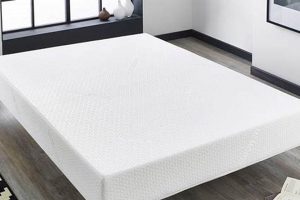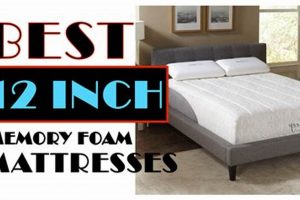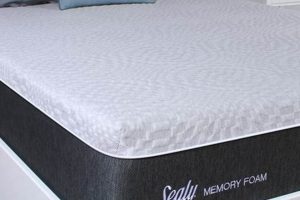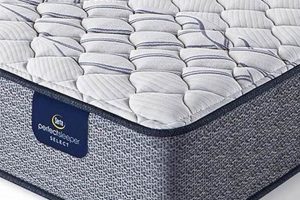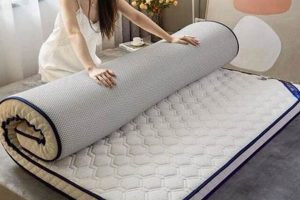Bed linens designed for use with viscoelastic foam mattresses often require specific features to accommodate the unique properties of the material. These coverings are typically crafted from materials that enhance the comfort and performance of the foam, such as breathable fabrics and deep pockets to fit the mattress’s thickness. For example, materials like bamboo or Tencel are favored for their moisture-wicking capabilities, addressing a common concern of heat retention associated with the foam itself.
The selection of appropriate bedding for these mattresses is important for optimizing the sleep experience. Breathable materials help regulate temperature, preventing overheating and promoting a more restful night. The deep-pocket design ensures a secure fit, preventing the sheets from slipping off the mattress, which can disrupt sleep. Historically, standard linens were often inadequate, leading to discomfort and requiring manufacturers to develop specialized products to meet the needs of consumers using these mattresses.
The subsequent sections will explore different material options, construction techniques, and care instructions for bedding designed to complement the specific characteristics of viscoelastic foam mattresses. Detailed analysis of thread count, weave patterns, and their impact on performance will be provided. Finally, considerations for selecting the optimal option based on individual sleep preferences and environmental factors will be addressed.
Selection and Care Tips for Viscoelastic Foam Mattress Linens
Selecting appropriate linens for a viscoelastic foam mattress requires careful consideration to maximize comfort and longevity. The following guidelines provide essential information for making informed decisions.
Tip 1: Prioritize Breathable Materials: Fabrics such as bamboo, Tencel, or linen are recommended due to their superior breathability. These materials mitigate the potential for heat retention often associated with foam mattresses, promoting a cooler and more comfortable sleep environment.
Tip 2: Confirm Deep Pocket Dimensions: Viscoelastic foam mattresses are often thicker than traditional innerspring mattresses. Ensure that the selected linens feature deep pockets to accommodate the mattress depth, preventing slippage and ensuring a secure fit. Measure the mattress’s thickness prior to purchase.
Tip 3: Consider Thread Count Strategically: While a high thread count is often associated with quality, it can also reduce breathability. Opt for a moderate thread count (between 300 and 500) in combination with a breathable fabric to balance comfort and temperature regulation.
Tip 4: Opt for Wrinkle-Resistant Finishes with Caution: Chemical treatments for wrinkle resistance can impact fabric breathability and potentially release volatile organic compounds (VOCs). If wrinkle resistance is desired, explore natural options like linen or consider laundering techniques to minimize wrinkles.
Tip 5: Implement Proper Laundering Procedures: Follow the manufacturer’s instructions for laundering. Use cold water and a gentle detergent to preserve the fabric’s integrity and prevent shrinkage. Avoid using bleach, as it can damage the fibers.
Tip 6: Rotate Linens Regularly: Rotating linens on a weekly basis promotes even wear and tear, extending their lifespan and maintaining optimal hygiene.
Tip 7: Consider Hypoallergenic Options: For individuals with allergies or sensitivities, select linens that are labeled as hypoallergenic and made from natural materials. These options can reduce exposure to allergens and irritants, promoting a healthier sleep environment.
These selection and care tips aim to enhance the sleep experience by addressing the specific requirements of viscoelastic foam mattresses. Adherence to these guidelines can contribute to improved comfort, hygiene, and product longevity.
The subsequent section will address common misconceptions and provide troubleshooting advice related to linen selection and maintenance for viscoelastic foam mattresses.
1. Material Breathability
Viscoelastic foam, a primary component of memory foam mattresses, tends to retain heat more than traditional innerspring counterparts. This characteristic necessitates the use of breathable materials in the associated coverings to mitigate potential discomfort and maintain a stable sleep temperature. Material breathability, therefore, becomes a critical attribute of coverings designed for memory foam mattresses. The selection of appropriate fabrics directly impacts the user’s thermal comfort. Non-breathable materials exacerbate heat retention, leading to elevated body temperature and potentially disrupting sleep cycles. Examples of breathable materials commonly used in coverings for these mattresses include bamboo-derived rayon, Tencel (lyocell), and linen. These fibers possess inherent moisture-wicking properties and allow for greater airflow, facilitating heat dissipation.
The implementation of breathable coverings has demonstrable effects on sleep quality. Studies have shown that individuals sleeping on memory foam mattresses with breathable coverings experience a reduction in nocturnal sweating and improved sleep duration compared to those using non-breathable alternatives. The practical application of this understanding extends to product development and marketing strategies. Manufacturers emphasize the breathability of their materials to appeal to consumers concerned about heat retention. Retailers often highlight the thermal performance of specific coverings as a key selling point for mattresses.
In conclusion, material breathability is an indispensable feature of coverings designed for memory foam mattresses. Its influence on sleep quality is significant, affecting both comfort and overall well-being. While advancements in foam technology continue to address heat retention, the selection of appropriate coverings remains crucial. Challenges persist in balancing breathability with other desirable characteristics, such as durability and cost-effectiveness. Nevertheless, the importance of breathable materials in the context of coverings for memory foam mattresses is well-established.
2. Deep Pocket Design
The dimensional characteristics of viscoelastic foam mattresses necessitate specialized design considerations in the manufacturing of bed linens. A primary adaptation is the “deep pocket” design, which directly addresses the increased thickness often exhibited by these mattresses compared to traditional innerspring models. The cause-and-effect relationship is clear: standard linens, designed for thinner mattresses, lack the depth to securely fit over a viscoelastic foam mattress. This results in slippage, bunching, and compromised comfort. The deep pocket design aims to resolve this issue by incorporating greater fabric depth, effectively accomm
odating the mattress’s overall height. Real-world examples of this design include fitted sheets with pocket depths ranging from 14 to 22 inches, specifically marketed for use with thicker mattresses.
The importance of deep pocket design extends beyond mere aesthetic considerations. A well-fitted sheet ensures even distribution of the sleeping surface, preventing pressure points and contributing to a more restful sleep experience. Furthermore, a secure fit prolongs the lifespan of the sheet itself by minimizing stress and tearing. For instance, consider a scenario where standard sheets are repeatedly stretched to fit a thicker mattress. The constant tension leads to accelerated fabric degradation and eventual failure. Deep pocket sheets, on the other hand, mitigate this risk by providing adequate material for secure and comfortable placement. Retailers categorize these products based on pocket depth, allowing consumers to select the appropriate option based on their mattress dimensions.
In conclusion, the deep pocket design is an integral component of bed linens intended for use with viscoelastic foam mattresses. This design modification directly addresses the dimensional challenges posed by the increased thickness of these mattresses, resulting in improved comfort, sheet longevity, and overall sleep quality. While the implementation of deep pockets may necessitate increased material usage and production costs, the benefits for consumers are substantial. The challenge lies in providing accurate and accessible information to consumers, ensuring they understand the importance of this design feature and can select appropriate linens for their specific mattress dimensions.
3. Thread Count Considerations
Thread count, often perceived as a definitive indicator of sheet quality, warrants nuanced consideration within the context of memory foam mattress sheets. While a higher thread count generally implies a softer, denser fabric, its impact on performance with memory foam is not unilaterally positive. The primary factor is the potential for reduced breathability. Viscoelastic foam inherently retains heat, and tightly woven, high thread count sheets can exacerbate this issue by restricting airflow. Conversely, excessively low thread counts may result in thinner, less durable sheets that offer diminished comfort. The practical consequence is that an indiscriminately high thread count can counteract the intended benefits of the memory foam mattress, leading to increased nighttime temperatures and disrupted sleep.
The ideal thread count for memory foam mattress sheets strikes a balance between softness, durability, and breathability. A range between 300 and 500 is often cited as optimal, particularly when coupled with breathable materials like bamboo or Tencel. For instance, a 400-thread count sheet made from long-staple cotton or bamboo rayon can provide a soft, comfortable surface while still allowing sufficient air circulation to dissipate heat. Furthermore, the type of weave influences the sheet’s characteristics. Percale weaves, with their crisp, breathable texture, are often preferred over sateen weaves, which tend to be denser and retain more heat. The practical significance lies in tailoring the thread count and weave to complement the thermal properties of the memory foam mattress, preventing overheating and maximizing sleep comfort.
In summary, thread count is a relevant but not absolute determinant of sheet suitability for memory foam mattresses. The prevailing consideration is its interplay with breathability. Selecting a thread count within a moderate range, combined with appropriate materials and weave patterns, promotes a comfortable and thermally balanced sleep environment. The challenge for consumers is to move beyond the simplistic association of high thread count with superior quality and instead prioritize the holistic performance of the sheet in conjunction with the specific characteristics of the memory foam mattress.
4. Fabric Composition
The selection of fabric composition for bed linens used in conjunction with viscoelastic foam mattresses is a significant determinant of the sleep experience. This relationship is predicated on the inherent thermal properties of viscoelastic foam, which tends to retain heat more readily than traditional innerspring mattresses. Consequently, the fabric composition of sheets plays a crucial role in regulating temperature and managing moisture, mitigating potential discomfort. For instance, synthetic materials such as polyester, while often durable and cost-effective, possess limited breathability. This characteristic can exacerbate heat retention, leading to elevated body temperature and disrupted sleep. Conversely, natural fibers like cotton, linen, or bamboo rayon offer enhanced breathability and moisture-wicking capabilities. These properties facilitate airflow and promote evaporation, contributing to a cooler and drier sleep environment. A practical example is the use of Tencel lyocell, a cellulose fiber derived from wood pulp, which exhibits exceptional moisture management and temperature regulation, making it a suitable choice for those susceptible to overheating.
The choice of fabric composition also impacts the tactile qualities of the bed linens. The softness, drape, and overall feel of the fabric contribute to the user’s comfort and satisfaction. For example, long-staple cotton varieties, such as Egyptian or Pima cotton, are known for their smooth, luxurious texture. Similarly, bamboo rayon provides a silky feel and excellent drape. Beyond comfort, fabric composition influences durability and ease of care. Some fabrics, like linen, possess inherent strength and resistance to wear and tear, while others may require more delicate handling. The practical application of this understanding is evident in the product development strategies of linen manufacturers. Retailers often provide detailed descriptions of the fabric composition, highlighting its unique properties and benefits, enabling consumers to make informed decisions based on their individual needs and preferences. Furthermore, certain fabric compositions may be treated with finishes that enhance wrinkle resistance or stain repellency, further contributing to their practicality and appeal.
In summary, the fabric composition of bed linens is a critical factor to consider when optimizing the sleep environment associated with viscoelastic foam mattresses. The material’s breathability, moisture-wicking capabilities, tactile properties, and durability all contribute to the overall comfort and satisfaction of the user. Selecting fabrics that complement the thermal properties of the mattress is essential for preventing overheating and promoting restful sleep. While synthetic materials may offer certain advantages in terms of cost and durability, natural fibers generally provide superior breathability and moisture management. The challenge for consumers lies in navigating the diverse array of available fabric options and prioritizing those that align with their specific needs and preferences. Fabric care should also be considered as per the instructions to increase its comfortability and usage.
5. Secure Fit Importance
The term “secure fit” is a critical attribute for
coverings designed for viscoelastic foam mattresses. This stems from the inherent properties of memory foam, which conforms to the body and can make movement more difficult compared to traditional innerspring mattresses. Ill-fitting coverings, such as sheets that are too small or lack adequate elasticity, are prone to slipping and bunching, thereby impeding movement and creating pressure points that disrupt sleep. The cause-and-effect relationship is direct: a poorly fitted sheet compromises the conforming benefits of the mattress, leading to a less restful experience. A secure fit, therefore, is not merely an aesthetic preference but a functional requirement for optimizing the performance of memory foam mattresses.
The importance of a secure fit manifests in several practical ways. First, it ensures consistent surface tension across the mattress, preventing uneven pressure distribution. Second, it minimizes friction between the body and the sheet, facilitating easier movement and reducing the likelihood of skin irritation. Third, it prolongs the lifespan of the sheet by preventing excessive stretching and tearing. Real-world examples include fitted sheets with deep pockets and robust elastic bands, specifically designed to accommodate the thickness and contours of memory foam mattresses. The practical significance of this understanding is reflected in the market, where consumers actively seek out and prioritize fitted sheets that offer a secure and reliable fit.
In summary, the concept of a “secure fit” is inextricably linked to the efficacy of coverings used with viscoelastic foam mattresses. It is a functional imperative that directly influences sleep quality, comfort, and the longevity of the bedding itself. While material composition and thread count are important considerations, a secure fit is the foundational element that ensures the sheet performs its intended function without detracting from the unique benefits of memory foam. The challenge remains in accurately conveying the importance of fit to consumers and providing clear sizing guidelines that enable them to select the appropriate bedding for their specific mattress dimensions.
6. Temperature Regulation
Temperature regulation is a crucial consideration when selecting bed linens for use with viscoelastic foam mattresses. The inherent properties of memory foam often lead to heat retention, which can disrupt sleep if not properly addressed by the linens. The materials and construction of coverings play a pivotal role in managing temperature and promoting a comfortable sleep environment.
- Material Breathability
The breathability of the sheet material is paramount in regulating temperature. Fabrics such as bamboo, Tencel, and linen allow for greater airflow than synthetic alternatives like polyester. This increased airflow facilitates the dissipation of heat, preventing the buildup of excess warmth during sleep. For instance, a sheet made of bamboo rayon can wick away moisture and promote evaporation, keeping the sleeper cooler and drier throughout the night.
- Moisture-Wicking Properties
Effective temperature regulation involves managing moisture as well as heat. Materials with moisture-wicking properties draw perspiration away from the skin, allowing it to evaporate and further contributing to a cooler sleep environment. Cotton, while breathable, is less effective at wicking moisture than bamboo or Tencel. The choice of fabric, therefore, should consider both breathability and moisture management capabilities.
- Weave and Thread Count
The weave pattern and thread count of the sheet also influence temperature regulation. Tightly woven fabrics, even those made from breathable materials, can restrict airflow and trap heat. A lower thread count combined with a loose weave, such as percale, promotes better ventilation. Conversely, sateen weaves, while offering a soft feel, tend to be denser and retain more heat.
- Construction Techniques
The manner in which the sheet is constructed can also impact temperature regulation. Features such as open seams and strategically placed ventilation panels can enhance airflow and promote cooling. Some manufacturers incorporate phase-change materials into their sheets to actively regulate temperature by absorbing and releasing heat as needed. These innovative technologies represent advancements in temperature regulation for bed linens.
The interplay between material, construction, and individual physiology ultimately determines the effectiveness of temperature regulation in bed linens designed for memory foam mattresses. Consumers should prioritize breathability and moisture management when selecting coverings to ensure a comfortable and restful sleep. Innovations in fabric technology continue to improve temperature regulation, offering enhanced comfort for those who sleep on memory foam.
7. Care Instructions
Proper care is paramount to preserving the integrity and prolonging the lifespan of bed linens used with viscoelastic foam mattresses. The specific nature of these mattresses, particularly their heat retention properties and tendency to conform to the body, necessitates adherence to particular laundering and maintenance protocols.
- Washing Frequency and Method
The frequency with which bed linens are laundered directly impacts their hygiene and durability. Excessive washing can degrade fabric fibers, while infrequent washing promotes the accumulation of allergens and body oils. A general recommendation is to wash sheets weekly in cold water to minimize shrinkage and color fading. The use of a gentle detergent is advised to prevent damage to the fabric. Avoid harsh chemicals, such as bleach, which can weaken fibers and compromise the breathability of materials like bamboo or Tencel.
- Drying Procedures
The method of drying bed linens significantly affects their texture and lifespan. High heat settings can cause shrinkage, warping, and damage to elastic components in fitted sheets. Tumble drying on a low heat setting or air drying is preferred. Air drying, in particular, preserves the fabric’s integrity and minimizes wrinkles. When using a dryer, remove the linens promptly to prevent overheating and static cling.
- Ironing and Wrinkle Management
While ironing can enhance the appearance of bed linens, it is not always necessary or recommended. High heat from an iron can damage certain fabric types, particularly synthetics or blends containing elastic fibers. If ironing is desired, use a low heat setting and iron the linens while they are slightly damp. Alternatively, wrinkle-resistant finishes can reduce the need for ironing, but these finishes may impact breathability. The decision to iron or not should be guided by the fabric composition and personal preference.
- Storage Practices
Proper storage is essential for preventing mildew, discoloration, and pest infestations. Bed linens should be stored in a clean, dry, and well-ventilated area. Avoid storing them in damp or humid environments, as this promotes the growth of mold and mildew. Storing linens in cotton or linen bags allows them to breathe while protecting them from dust and insects. Avoid using plastic bags, as they can trap moisture and create a breeding ground for mold.
Adhering to these ca
re instructions is essential for maintaining the hygiene, comfort, and longevity of coverings designed for viscoelastic foam mattresses. By following these protocols, consumers can maximize the performance and lifespan of their bed linens, ensuring a more comfortable and restful sleep. Deviations from these protocols can lead to premature wear, reduced breathability, and compromised hygiene, negating the benefits of using specialized linens with memory foam mattresses.
Frequently Asked Questions
The following addresses common inquiries regarding the selection, care, and performance of coverings designed for use with viscoelastic foam mattresses. These answers aim to provide clarity and informed guidance.
Question 1: Do specialized coverings genuinely enhance the sleep experience on a memory foam mattress?
Yes, specialized coverings address the unique thermal and dimensional characteristics of viscoelastic foam. They promote breathability, ensure a secure fit, and contribute to overall comfort.
Question 2: What materials are most suitable for achieving optimal breathability in bed linens for such mattresses?
Bamboo rayon, Tencel (lyocell), and linen are recognized for their superior breathability and moisture-wicking properties, mitigating heat retention.
Question 3: Why is a deep pocket design essential for fitted sheets used with viscoelastic foam?
Viscoelastic foam mattresses often possess greater thickness than traditional innerspring models. Deep pockets accommodate this increased depth, preventing slippage and ensuring a secure fit.
Question 4: Is a high thread count invariably indicative of superior quality in this context?
Not necessarily. While a high thread count can enhance softness, it can also impede breathability. A moderate thread count (300-500), combined with breathable materials, is often preferable.
Question 5: How frequently should these bed linens be laundered, and what cleaning methods are recommended?
Weekly laundering in cold water with a gentle detergent is advisable. Avoid harsh chemicals and high heat, as these can damage fabric fibers. Tumble drying on low or air drying is recommended.
Question 6: What are the implications of using standard, non-specialized coverings on a viscoelastic foam mattress?
The use of standard coverings can compromise breathability, fit, and overall comfort, potentially negating some of the benefits associated with the memory foam mattress itself.
In summary, careful consideration of material, construction, and care practices is essential for maximizing the benefits of bedding designed for use with viscoelastic foam mattresses.
The subsequent section will delve into advanced topics, including the role of innovative materials and technologies in further optimizing the sleep experience.
Conclusion
This exploration of memory foam mattress sheets has illuminated the critical interplay between bedding and mattress characteristics. Factors such as material breathability, pocket depth, and thread count significantly impact sleep quality. Selecting appropriate linens tailored to the specific properties of viscoelastic foam is not merely an aesthetic choice but a functional necessity. Proper care and maintenance further contribute to the longevity and performance of both the bedding and the mattress itself.
The industry will likely witness continued innovation in materials and designs aimed at optimizing the sleep environment. Prioritizing informed decision-making, grounded in an understanding of these key factors, will empower consumers to enhance their sleep experience and maximize the investment in their sleep systems. Ongoing research and development within this sector remain crucial for advancing comfort and promoting restful sleep through optimized bedding solutions.


